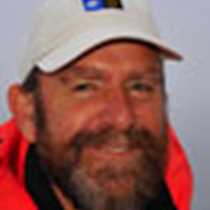Torgersen Island, Palmer Station
After the excitement of the last few days (a seamless series of rollercoaster adventures under blistering blue Antarctic skies), it was a relief to wake to an overcast day, air temperature of 0°C. Those of us with muzzy heads and red noses gazed cautiously out of the windows: where are we? Bearing down on the Argentine Islands, but still no word from our Expedition Leader, Matt Drennan, who had promised us “something different.” There was a whale of a start to the day as a frisky humpback breached 3 times right outside the dining room, causing spilt cornflakes at a dozen breakfast tables. But wait, the oracle speaks: “Good Morning, everybody – we have permission to land at the Palmer Station US research base today: Zodiacs down at 1330.” A sudden hubbub of excitement: this busy station allows no more than a dozen visits a season, but Matt had somehow won an unexpected opportunity to interrupt their busy programme of work. After being shown around the research buildings, where meticulous meteorological, oceanographic and ecological work takes place, we formed our own meticulous food chain to sample the Giant Palmer Brownie, possibly the largest cookie in the world.
Then we made our own modest contribution to one of their ecological experiments. We sped across choppy water to wade ashore on Torgersen Island, where the adelie penguin colonies have been studied for nearly 25 years. The island is bisected by a line of green flags, one side open to visitors, the other left undisturbed. We sat close and watched, thrilled to see a colony at last where all pairs were busy with fat twin chicks, each sub-colony furnished with the telltale krill-pink deep-pile carpet. Two of the station ornithologists confirmed that despite 5 years of regular visitors, there is no difference in the breeding success either side of the line. With increasing tourist numbers to Antarctica each season, all keen to see penguins, this finding is reassuring. Instead, the 25-year run of data here shows that adelie breeding success is more closely related to extent of pack-ice in the peninsula. As this shrinks with global warming, the local adelie population has dropped by 75% in recent years. Warmer temperatures mean warmer seas, which reduce the sea-ice on which adelies depend to feed, and paradoxically cause heavier spring snowfalls that bury the traditional breeding sites of gentoos and chinstraps for months beyond their normal laying date. As if to underline the point, snow started to fall as we pondered trends. Is this global warming? Are we causing this? If anyone can answer these questions, it will be the scientists of Palmer Station. We need to think long and hard about the effect we are having on this precious little planet of ours; and resolve to cherish a world in which we can thrill at the sight of cobalt blue icebergs sailing through an ocean fizzing with krill, whales and penguins.
After the excitement of the last few days (a seamless series of rollercoaster adventures under blistering blue Antarctic skies), it was a relief to wake to an overcast day, air temperature of 0°C. Those of us with muzzy heads and red noses gazed cautiously out of the windows: where are we? Bearing down on the Argentine Islands, but still no word from our Expedition Leader, Matt Drennan, who had promised us “something different.” There was a whale of a start to the day as a frisky humpback breached 3 times right outside the dining room, causing spilt cornflakes at a dozen breakfast tables. But wait, the oracle speaks: “Good Morning, everybody – we have permission to land at the Palmer Station US research base today: Zodiacs down at 1330.” A sudden hubbub of excitement: this busy station allows no more than a dozen visits a season, but Matt had somehow won an unexpected opportunity to interrupt their busy programme of work. After being shown around the research buildings, where meticulous meteorological, oceanographic and ecological work takes place, we formed our own meticulous food chain to sample the Giant Palmer Brownie, possibly the largest cookie in the world.
Then we made our own modest contribution to one of their ecological experiments. We sped across choppy water to wade ashore on Torgersen Island, where the adelie penguin colonies have been studied for nearly 25 years. The island is bisected by a line of green flags, one side open to visitors, the other left undisturbed. We sat close and watched, thrilled to see a colony at last where all pairs were busy with fat twin chicks, each sub-colony furnished with the telltale krill-pink deep-pile carpet. Two of the station ornithologists confirmed that despite 5 years of regular visitors, there is no difference in the breeding success either side of the line. With increasing tourist numbers to Antarctica each season, all keen to see penguins, this finding is reassuring. Instead, the 25-year run of data here shows that adelie breeding success is more closely related to extent of pack-ice in the peninsula. As this shrinks with global warming, the local adelie population has dropped by 75% in recent years. Warmer temperatures mean warmer seas, which reduce the sea-ice on which adelies depend to feed, and paradoxically cause heavier spring snowfalls that bury the traditional breeding sites of gentoos and chinstraps for months beyond their normal laying date. As if to underline the point, snow started to fall as we pondered trends. Is this global warming? Are we causing this? If anyone can answer these questions, it will be the scientists of Palmer Station. We need to think long and hard about the effect we are having on this precious little planet of ours; and resolve to cherish a world in which we can thrill at the sight of cobalt blue icebergs sailing through an ocean fizzing with krill, whales and penguins.




